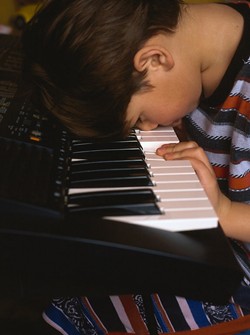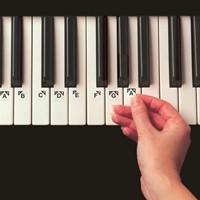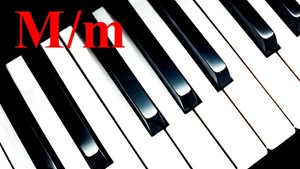
First, I want to say that "learn to play the piano" can have many connotations to different people. If you started out as a child and took traditional piano lessons in which everything from day one was about reading music, playing with precision at the correct tempo and slowly moving from one method peice to the next, your definition of "learning to play the Piano" would be hours of boredom every week that goes on for years.
This ultimately gives you a general skill in piano playing that allows most people to play basic piano  arrangements.
arrangements.
On the other hand, if you have an understanding of the mechanics of music, in other words, how music works, then you essentially learn to play music partly by ear and partly by chords and chord patterns.
I use the term "mechanics of music" rather than "music theory". I don't like to use the term "music theory" because a theory is an educated guess about something (at least in my mind). So I think that the term "mechanics of music" can be a better way of describing how music works.
But either way it doesn't really matter what you call it. What matters is that you have a clear understanding of music and are able to put it to practice and get some real results. So lets talk about the five simple steps to learn to play the piano.
Number 1: Learn the notes on the keyboard. I know this is obvious but there's actually people trying to play chords and progressions that don't even know their keyboard notes. What's just as bad, is people using inserts behind the keys and putting stickers and tape on  them with written note names.
them with written note names.
Don't do this. You don't need to. It's just too easy to learn the notes on the keyboard. You'll find a clear and easy to understand tutorial right here. It's the fastest way to learn your keyboard notes and I have a worksheet available that won't cost you anything. So learn your keyboard notes.
Number 2: Learn the 12 Major and minor Chords. First, It's very easy to learn all 12 Major Chords. You should learn them because they're the king of all chords. This means that every chord is based on these 12 Major Chords. You shouldn't be concerned about minor, diminished, augmented, 7th, extended, altered or any other kind of chord until you learn these first.
Here's a tutorial on the fastest way to learn the 12 Major Chords. I teach them to you in four groups of three instead of just a laundry  list of 12 different chords.
list of 12 different chords.
You'll be rewarded for learning the 12 Major Chords because they're a foundation building tool that will benefit you for the rest of your life. Because when you start learning songs, you're not going get lost trying to figure out where a specific type of chord came from and the concept behind it.
So learn the 12 Major chords. Afterwards, you learn the 12 minor chords. This is going to take a fraction of the time it took you to learn the 12 Major chords because you're literally a half step away from learning the 12 minor chords. Here's the tutorial on it and you'll get the worksheet that won't cost you anything to cement this skill in your brain. So learn all 12 Major and minor chords.
Number 3: Learn chord inversions. That just simply means to learn how to play the 12 Major and minor chords you just learned in all three possible positions. In other words, learn how to rearrange the notes in the chords. For example, here's G Major in root position but in order to make it sound like a professional sounding chord you may play it like this. Or you may play it like this. The point is: chords are not often played in root position. They're spread out in what's referred to as open voicing. The notes of the chords are played in both hands. A full tutorial with a video on inversions can be found here.
They may inverted be to accommodate a melody note. Melody notes have to be on top of the chord. If not, you can't hear them. If I am playing a G Major chord and my melody note is B, I have to play it like this. And if I just change this one note in my left hand, then I'm playing an entirely different chord. It's now an extended chord that's known as E minor seven. Here's a tutorial on the screen for learning chord inversions. This leads me right into step number 4.
Number 4: Learn extended and altered chords. Extended chords are major or minor triads that have one or more tones beyond just the triad. For example, the C Major chord with the added A in the bass is actually an A minor seven chord. Seventh chords are probably the most common extended chords.
Ninths, elevenths and thirteenth chords are also common in all kinds of popular music. And you also can alter those extended chords. For example with the C nine chord, you can flat the ninth and sharp the fifth.

This creates a dissonant sounding chord, but it will sound good in the context of a song. I could spend an infinite amount of time on this but just remember that extended and altered chords are a big part of sounding like a pro. Here's a tutorial on 7th chords that will get your started learning extended chords.
 Number 5: Learn how to read lead sheets. This is probably among the most traditional keyboard playing skill that I suggest that you learn. This is the only type of music reading that I don't mind because number one: it's so easy compared to reading a whole bunch of notes on the grand staff and number two: playing melodies are a big part of keyboard playing. That's not to say that you have to play every note in a piece of written music but the melody is the most recognizable part of a song.
Number 5: Learn how to read lead sheets. This is probably among the most traditional keyboard playing skill that I suggest that you learn. This is the only type of music reading that I don't mind because number one: it's so easy compared to reading a whole bunch of notes on the grand staff and number two: playing melodies are a big part of keyboard playing. That's not to say that you have to play every note in a piece of written music but the melody is the most recognizable part of a song.
Lead sheets are the most common type of written music that pro keyboard players play because it's very simple to read and it's the minimum amount of written music you can find. It has a one note melody and chord symbols and that's it. Here's a tutorial on how to use a lead sheet for professional sounding results at the piano.
You just play the melody and play the harmony underneath it. You can get a collection of lead sheets called a fake book. You can also play from lead sheets just by ignoring the melody line and playing the chords by themselves with a some type of rhythm pattern.
Learn By the Numbers: Okay, here's a bonus. Learn the number system. This is probably the most powerful skill to help you learn to play the piano. Most traditional piano lessons will never focus on the number system. This is because of the emphasis on teaching you how to read music as I mentioned at the start of this article.
The number system is like a magic key that unlocks the essence of any popular song. It allows you to play any chord, progression, chord voicing, etc. in any key because it identifies the structure of music instead of just notes. The exciting fact about the number system is that it's incredibly simple and easy to learn.
The number system is more formally referred to as the Nashville Number System. It's simply based on the seven different notes of a scale or key of music. Each tone or note has a corresponding number and a chord on which it's built. A complete knowledge of numbers and their corresponding notes allow you to play/create chords and chord progressions in any key as well as transpose them to other keys.
Musicians have been using this system for years because it's easier to play music with. These are the skills needed to be a well rounded piano player without the need to be a traditional note reader (which I often cite as the reason most piano students quit piano lessons).
There are so many other possibilities for you to grow in music other than what I've mentioned here. But I'll have to say that taking these 5 steps to learn to play the piano will give you tremendous growth as a musicians.
Once you understand and start developing these skills, you build on them and that's when you're going to obtain the skills to sound like a professional. And yes, these are simple steps that you can start taking even if you're a fresh beginner at the piano.
Make sure that you visit the pages and go through the tutorials that I mentioned because it really is that simple to learn how to be a musician at the keyboard and sound like a pro.
Until next time, Go Play!
Greg Lee
Latest posts by Greg Lee (see all)
- What is a minor/Major 7 Chord? - October 26, 2023
- 7 Chord Substitutions that Professionals Use - October 19, 2023
- 5 Simple Chord Tricks to Sound Amazing - October 5, 2023



